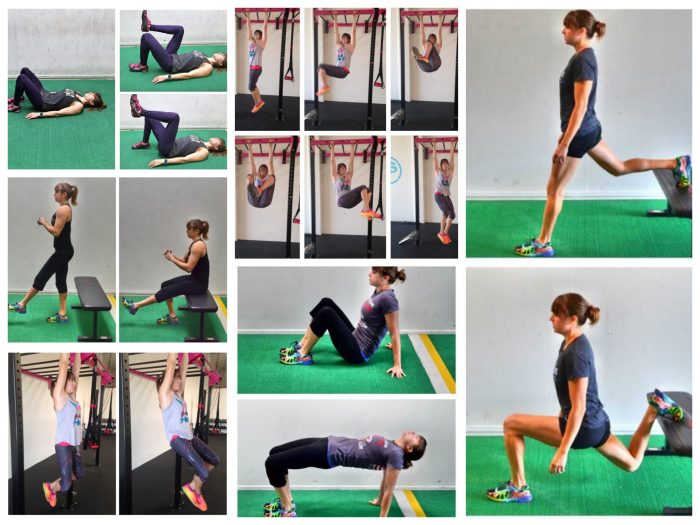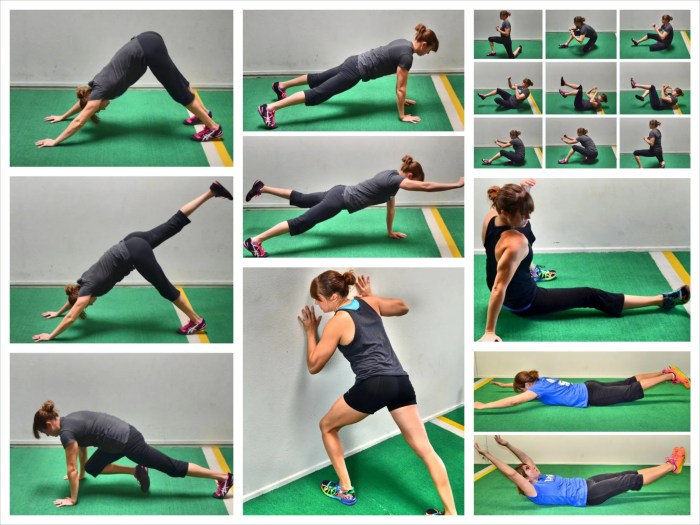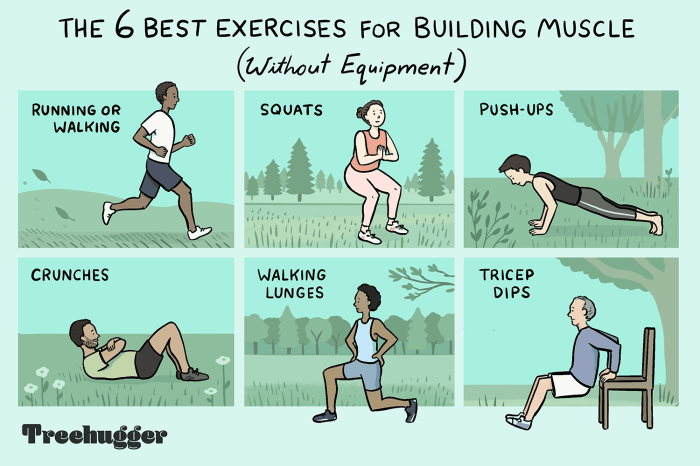Exercises to increase strength are essential for building muscle, improving performance, and maintaining overall health. This comprehensive guide will provide you with the knowledge and tools you need to effectively incorporate strength training into your fitness routine.
Strength training offers numerous benefits, including increased muscle mass, improved bone density, reduced risk of injury, and enhanced metabolic function. By engaging in regular strength training exercises, you can unlock your body’s potential and achieve your fitness goals.
Introduction
Strength training is a form of exercise that involves the use of weights or resistance to build muscle strength and increase overall fitness. It is an essential part of any well-rounded exercise program, as it offers numerous benefits for both physical and mental health.Regular strength training can help to:
- Improve muscle strength and endurance
- Increase bone density
- Reduce the risk of injury
- Improve balance and coordination
- Boost metabolism
- Enhance mood and cognitive function
There are many different types of strength training exercises, each of which targets specific muscle groups. Some of the most common exercises include:
- Squats
- Lunges
- Push-ups
- Pull-ups
- Rows
- Bench press
- Overhead press
Strength training programs can be tailored to individual fitness levels and goals. There are three main types of strength training programs:
Bodyweight training
Uses your own body weight as resistance.
Free weight training
Uses weights that are not attached to a machine.
Machine training
Uses weights that are attached to a machine.It is important to warm up before strength training to prepare your muscles for the workout. A warm-up should include light cardio and dynamic stretching. Cooling down after strength training is also important to help your muscles recover.
A cool-down should include static stretching.
Types of Strength Exercises

Strength exercises are an essential part of any fitness routine. They can help you build muscle, burn fat, and improve your overall health. There are many different types of strength exercises, each with its own benefits. Choosing the right exercises for you will depend on your fitness level, goals, and available equipment.
The main types of strength exercises are:
Bodyweight Exercises
Bodyweight exercises are exercises that you can do without any equipment. They are a great way to get started with strength training, as they are easy to learn and can be done anywhere. Some examples of bodyweight exercises include:
- Push-ups
- Squats
- Lunges
- Pull-ups
Progressive Overload
Progressive overload is a fundamental principle in strength training that involves gradually increasing the demands placed on your muscles over time. By consistently challenging your muscles with heavier weights or increased resistance, you stimulate muscle growth and strength gains.
The key to progressive overload is to increase the weight or resistance in small, manageable increments. This allows your muscles to adapt and recover without overwhelming them. Over time, as your muscles become stronger, you can continue to increase the weight or resistance to maintain the challenge.
Gradual Increase in Weight or Resistance
- Start with a weight or resistance that is challenging but achievable.You should be able to perform 8-12 repetitions of an exercise with good form.
- Once you can comfortably perform 12 repetitions, increase the weight or resistance by 5-10%.This will provide a new challenge for your muscles and stimulate further growth.
- Continue to increase the weight or resistance gradually as you get stronger.Aim to add weight or resistance every 1-2 weeks, or as needed.
Examples of Progressive Overload in Strength Training
- Barbell squats:Gradually increase the weight on the barbell as you become stronger.
- Push-ups:Start with regular push-ups and progress to more challenging variations such as incline push-ups, decline push-ups, or weighted push-ups.
- Dumbbell rows:Increase the weight of the dumbbells as you get stronger.
Exercise Selection
Exercise selection is crucial for targeting specific muscle groups and achieving optimal strength gains. It involves choosing exercises that effectively work the desired muscles while considering variations to accommodate different fitness levels.
Best Exercises for Different Muscle Groups
Here are the best exercises for targeting different muscle groups:
- Chest:Barbell bench press, incline dumbbell press, push-ups
- Back:Barbell row, lat pulldown, pull-ups
- Shoulders:Overhead press, lateral raise, front raise
- Legs (quads):Barbell squat, leg press, lunges
- Legs (hamstrings):Romanian deadlift, leg curl, glute bridge
- Legs (calves):Calf raise, seated calf raise
- Core:Plank, side plank, Russian twist
Importance of Compound Exercises
Compound exercises work multiple muscle groups simultaneously, making them highly efficient for building strength and muscle mass. Examples include squats, deadlifts, bench press, and overhead press.
Variations for Different Fitness Levels
Exercise variations can accommodate different fitness levels and allow for progression:
- Beginners:Start with bodyweight exercises, machines, or lighter weights.
- Intermediate:Use compound exercises, increase weight or resistance.
- Advanced:Incorporate advanced variations like supersets, drop sets, or isometric holds.
| Muscle Group | Exercises |
|---|---|
| Chest | Barbell bench press, incline dumbbell press, push-ups |
| Back | Barbell row, lat pulldown, pull-ups |
| Shoulders | Overhead press, lateral raise, front raise |
| Legs (quads) | Barbell squat, leg press, lunges |
| Legs (hamstrings) | Romanian deadlift, leg curl, glute bridge |
| Legs (calves) | Calf raise, seated calf raise |
| Core | Plank, side plank, Russian twist |
Workout Structure

The structure of your workout is essential for maximizing your results. It includes the warm-up, the exercises, and the cool-down.
Warm-ups and Cool-downs
Warming up before your workout helps to prepare your body for the activity ahead. It increases your heart rate, blood flow, and muscle temperature, which can help to prevent injuries and improve performance. Cool-downs after your workout help to reduce muscle soreness and stiffness, and can also help to prevent injuries.
Some examples of warm-up exercises include:
- Light cardio, such as jogging or cycling
- Dynamic stretching, such as arm circles or leg swings
- Bodyweight exercises, such as squats or push-ups
Some examples of cool-down exercises include:
- Static stretching, such as holding a stretch for 30 seconds or more
- Foam rolling
- Yoga
Training Splits
A training split is a way of organizing your workouts so that you work different muscle groups on different days. There are many different training splits, but some of the most popular include:
- Full-body workouts:You work all of your muscle groups in each workout.
- Upper/lower body splits:You work your upper body on one day and your lower body on the next.
- Push/pull/legs splits:You work your pushing muscles (chest, shoulders, and triceps) on one day, your pulling muscles (back and biceps) on the next, and your legs on the third day.
The best training split for you depends on your individual needs and goals. If you’re new to strength training, you may want to start with a full-body workout. As you get stronger, you may want to switch to a more advanced training split.
Exercise Form

Proper exercise form is crucial for maximizing the benefits of your workouts and minimizing the risk of injury. When you perform exercises with correct form, you target the intended muscles effectively, engage your core and stabilizers, and maintain proper alignment throughout the movement.
Common Mistakes to Avoid
- Arching your back:This can put strain on your lower back and lead to pain or injury.
- Rounding your shoulders:This can lead to shoulder impingement and rotator cuff tears.
- Not engaging your core:A weak core can compromise your stability and increase the risk of injury.
- Using too much weight:Lifting too heavy can lead to poor form and increase the risk of injury.
- Not breathing properly:Holding your breath during exercises can raise your blood pressure and compromise your form.
Examples of Exercises with Proper Form
Here are some examples of exercises performed with proper form:
- Squats:Stand with your feet hip-width apart, toes slightly turned out. Lower your body by bending your knees and hips, keeping your back straight and your core engaged.
- Push-ups:Start in a plank position with your hands shoulder-width apart. Lower your body by bending your elbows, keeping your core engaged and your body in a straight line from head to heels.
- Rows:Sit on a bench with your feet flat on the floor. Hold a dumbbell in each hand and pull them towards your chest, keeping your elbows tucked in and your back straight.
Elaborate on the relationship between training frequency, intensity, and volume: Exercises To Increase Strength

Training frequency, intensity, and volume are three key variables that influence the effectiveness of strength training programs. Frequency refers to the number of times per week an exercise is performed, intensity measures the effort exerted during the exercise, and volume represents the total amount of work done.
These variables are interrelated and must be carefully balanced to optimize results.
Generally, higher training frequency leads to greater muscle growth and strength gains. However, too much frequency can lead to overtraining and burnout. Intensity is another important factor, as it determines the level of muscle activation and recruitment. Higher intensity workouts can produce greater strength gains, but they also require longer recovery periods.
Volume is the total amount of work done during a training session, and it is determined by the number of sets, repetitions, and weight used. Higher volume workouts can lead to greater muscle growth, but they also require more recovery time.
The optimal combination of frequency, intensity, and volume will vary depending on individual factors such as training experience, fitness level, and recovery capacity.
Progressive Overload
Progressive overload is a fundamental principle of strength training. It involves gradually increasing the demands placed on the muscles over time, which forces them to adapt and grow stronger. This can be achieved by increasing the weight lifted, the number of sets or repetitions, or the frequency of training sessions.
Adjusting Frequency and Intensity
The optimal training frequency and intensity will vary depending on individual needs and goals. Beginners should start with a lower frequency and intensity and gradually increase them over time as they become more conditioned. More experienced lifters may need to use higher frequency and intensity to continue making progress.
Deloads and Rest Days
Deloads and rest days are an essential part of any strength training program. Deloads are periods of reduced training volume and intensity, which allow the body to recover and rebuild. Rest days are complete days off from training, which allow the body to fully recover.
Both deloads and rest days are necessary for optimal progress and to prevent overtraining.
Training Schedules
The following table summarizes different training schedules with varying frequency and intensity.| Frequency| Intensity| Volume||—|—|—|| 2-3 days per week | Low-moderate | Low-moderate || 3-4 days per week | Moderate-high | Moderate-high || 5-6 days per week | High | High |
– Nutrition for Strength Training
Proper nutrition is essential for maximizing the benefits of strength training. It provides the body with the necessary fuel and building blocks to repair and grow muscle tissue, leading to increased strength and performance.
The Role of Macronutrients
The three macronutrients—protein, carbohydrates, and fats—play crucial roles in strength training:
- Protein:Essential for muscle repair and growth. Aim for 1.6-2.2 grams per kilogram of body weight per day.
- Carbohydrates:Provide energy for intense workouts. Consume 6-10 grams per kilogram of body weight per day.
- Fats:Support hormone production and provide energy. Aim for 1-1.2 grams per kilogram of body weight per day.
Healthy Diet for Strength Training
A balanced diet for strength training should include:
- Lean protein:Chicken, fish, tofu, beans, lentils
- Complex carbohydrates:Whole grains, brown rice, fruits, vegetables
- Healthy fats:Avocados, nuts, olive oil
Key Nutrients for Strength Training
The following table summarizes the key nutrients for strength training, along with their recommended daily intake and food sources:
| Nutrient | Recommended Daily Intake | Food Sources |
|---|---|---|
| Protein | 1.6-2.2 grams per kilogram of body weight | Chicken, fish, tofu, beans, lentils |
| Carbohydrates | 6-10 grams per kilogram of body weight | Whole grains, brown rice, fruits, vegetables |
| Fats | 1-1.2 grams per kilogram of body weight | Avocados, nuts, olive oil |
| Calcium | 1,000-1,200 milligrams | Dairy products, leafy green vegetables |
| Iron | 8-18 milligrams | Red meat, spinach, fortified cereals |
| Vitamin D | 600-800 IU | Fatty fish, fortified milk, sunlight exposure |
It’s important to consult with a registered dietitian or healthcare professional for personalized nutrition advice tailored to your specific needs and goals.
Recovery
Recovery is an essential part of any strength training program. It allows your body to repair itself, rebuild muscle tissue, and prepare for your next workout. Without adequate recovery, you may experience overtraining, which can lead to decreased performance, increased risk of injury, and burnout.
There are several key factors that contribute to recovery, including sleep, hydration, and nutrition. Sleep is essential for muscle repair and growth hormone production. Hydration helps to flush out waste products and deliver nutrients to your muscles. Nutrition provides the building blocks for muscle repair and recovery.
Types of Recovery Methods
There are two main types of recovery methods: passive and active.
- Passive recoveryinvolves resting and allowing your body to recover on its own. This can include activities such as sleeping, taking a nap, or reading a book.
- Active recoveryinvolves engaging in light activity that helps to promote blood flow and circulation. This can include activities such as walking, swimming, or yoga.
Both passive and active recovery are important for overall recovery. Passive recovery allows your body to rest and repair itself, while active recovery helps to promote blood flow and circulation, which can help to reduce muscle soreness and stiffness.
Importance of Rest Days
Rest days are an important part of any strength training program. They allow your body to recover from your workouts and prepare for your next workout. Rest days also help to reduce the risk of overtraining.
The number of rest days you need will vary depending on your fitness level and training intensity. However, most experts recommend taking at least one rest day per week.
Signs and Symptoms of Overtraining
Overtraining occurs when you push your body too hard without giving it enough time to recover. Overtraining can lead to a number of symptoms, including:
- Decreased performance
- Increased risk of injury
- Burnout
- Fatigue
- Muscle soreness
- Difficulty sleeping
- Loss of appetite
If you experience any of these symptoms, it is important to take a break from training and allow your body to recover.
Tips for Avoiding Overtraining
There are a number of things you can do to avoid overtraining, including:
- Listen to your body and take rest days when you need them.
- Gradually increase the intensity and volume of your workouts over time.
- Get enough sleep.
- Stay hydrated.
- Eat a healthy diet that includes plenty of protein.
By following these tips, you can help to avoid overtraining and maximize your results from strength training.
Importance of Nutrition for Recovery
Nutrition is an important part of recovery. The foods you eat after a workout can help to promote muscle repair and growth. Protein is particularly important for muscle recovery, as it provides the building blocks for muscle tissue.
In addition to protein, you should also eat carbohydrates and healthy fats after a workout. Carbohydrates provide energy for your muscles, while healthy fats help to reduce inflammation.
Role of Supplements in Recovery
Supplements can be helpful for promoting recovery from strength training. Some supplements that may be beneficial for recovery include:
- Protein powder
- Creatine
- BCAAs
- Glutamine
It is important to note that supplements are not a substitute for a healthy diet. If you are considering taking supplements, be sure to talk to your doctor first.
Sample Recovery Plan
Here is a sample recovery plan that you can follow after a strength training workout:
- Immediately after your workout, drink a protein shake or eat a protein-rich snack.
- Within 2 hours of your workout, eat a meal that includes protein, carbohydrates, and healthy fats.
- Get 7-8 hours of sleep.
- Take a rest day the day after your workout.
By following this recovery plan, you can help to maximize your results from strength training and reduce your risk of overtraining.
Sample Strength Training Programs

Strength training programs can vary based on your fitness level. Here are sample programs tailored to different levels:
Beginner-Friendly Strength Training Program
This program is designed for those new to strength training or returning after a long break. Focus on proper form and gradual progression:
- Frequency: 2-3 times per week
- Intensity: 60-70% of 1-repetition maximum (1RM)
- Volume: 2-3 sets of 8-12 repetitions per exercise
- Exercises: Compound exercises like squats, lunges, push-ups, and rows
- Rest periods: 60-90 seconds between sets
Intermediate-Level Strength Training Program
For individuals with some strength training experience, this program increases intensity and volume:
- Frequency: 3-4 times per week
- Intensity: 70-85% of 1RM
- Volume: 3-4 sets of 6-10 repetitions per exercise
- Exercises: Include isolation exercises in addition to compound exercises
- Rest periods: 60-90 seconds between sets
Advanced-Level Strength Training Program
This program is designed for experienced lifters seeking significant strength gains:
- Frequency: 4-5 times per week
- Intensity: 85-100% of 1RM
- Volume: 4-5 sets of 3-6 repetitions per exercise
- Exercises: Focus on heavy compound exercises with low repetitions
- Rest periods: 2-3 minutes between sets
Special Considerations
It’s crucial to consider the special needs of different populations when designing strength training programs.
Beginners
Beginners need to start with a manageable foundation to avoid injuries and promote progress.
- Focus on proper form and technique before adding weight.
- Choose exercises that target multiple muscle groups.
- Start with a low weight and gradually increase it as strength improves.
Seniors, Exercises to increase strength
Seniors may have reduced mobility, flexibility, and strength. Modifications are necessary to ensure safety and effectiveness.
- Use lighter weights and focus on exercises that improve balance and stability.
- Consider exercises that can be done seated or with support.
- Pay attention to rest periods and avoid overexertion.
Individuals with Injuries
Individuals with injuries require modifications to avoid aggravating the injury while still improving strength.
- Consult a healthcare professional for guidance.
- Modify exercises to minimize stress on the injured area.
- Focus on exercises that strengthen the muscles surrounding the injury.
Progression
Progressing exercises for different populations involves gradually increasing the intensity, volume, or frequency of training.
Table: Modifications for Different Populations
| Population | Modifications ||—|—|| Beginners | Low weight, proper form, multiple muscle group exercises || Seniors | Lighter weights, balance and stability exercises, rest periods || Individuals with Injuries | Exercises that avoid aggravating injury, strengthen surrounding muscles |
Table: Progression for Different Populations
| Population | Progression ||—|—|| Beginners | Gradually increase weight, add sets or repetitions || Seniors | Increase weight gradually, maintain balance and stability || Individuals with Injuries | Gradually increase intensity and volume as tolerated |
Tips for Beginners

Starting a strength training routine can be daunting, but it’s essential to approach it gradually to prevent injuries and maximize results.
Working with a Trainer
Consider working with a certified personal trainer who can guide you through proper form, exercise selection, and progression.
Staying Motivated and Consistent
- Set realistic goals and track your progress.
- Find an exercise buddy or join a fitness class for accountability.
- Make exercise a part of your routine, even if it’s just for a short period each day.
Common Mistakes
Beginners often make mistakes that can hinder their progress or even lead to injuries. It’s crucial to be aware of these common pitfalls and take steps to avoid them.
Overtraining
- Consequences:Fatigue, burnout, decreased performance, increased risk of injury
- Avoidance:Gradually increase training volume and intensity, listen to your body, and take rest days when needed.
Poor Form
- Consequences:Ineffective exercises, increased risk of injury
- Avoidance:Learn proper form from a qualified trainer, use mirrors or record yourself to check your technique, and focus on maintaining good form throughout your sets.
Neglecting Warm-Up and Cool-Down
- Consequences:Increased risk of injury, decreased performance
- Avoidance:Always warm up with light cardio and dynamic stretching before your workout, and cool down with static stretching afterward.
Ignoring Nutrition
- Consequences:Inadequate recovery, reduced energy levels, impaired muscle growth
- Avoidance:Consume a balanced diet rich in protein, carbohydrates, and healthy fats. Ensure adequate hydration by drinking plenty of water throughout the day.
Inconsistent Training
- Consequences:Limited progress, lack of motivation
- Avoidance:Establish a regular training schedule and stick to it as much as possible. Find activities that you enjoy to make training more sustainable.
Safety Considerations
Strength training can be an effective way to improve your overall health and fitness, but it’s important to do it safely. There are a few things you can do to minimize your risk of injury:
- Warm up before you start lifting weights.Warming up helps to prepare your muscles for the work ahead and reduce your risk of injury.
- Use proper form when lifting weights.Proper form helps to ensure that you are using the correct muscles and that you are not putting undue stress on your joints.
- Start with a weight that is challenging but not too heavy.As you get stronger, you can gradually increase the weight you are lifting.
- Listen to your body.If you feel pain, stop lifting and consult with a doctor or physical therapist.
Risks and Benefits of Different Exercises
Different strength training exercises carry different risks and benefits. Some exercises, such as squats and deadlifts, are compound exercises that work multiple muscle groups at once. These exercises can be very effective for building strength, but they can also be more risky if not done properly.
Other exercises, such as bicep curls and tricep extensions, are isolation exercises that work only one muscle group at a time. These exercises are less risky, but they can also be less effective for building strength.It’s important to choose exercises that are appropriate for your fitness level and goals.
If you are new to strength training, it’s a good idea to start with simple exercises and gradually add more challenging exercises as you get stronger.
Tips for Preventing Injuries
Here are a few tips for preventing injuries when strength training:
- Warm up before you start lifting weights.Warming up helps to prepare your muscles for the work ahead and reduce your risk of injury.
- Use proper form when lifting weights.Proper form helps to ensure that you are using the correct muscles and that you are not putting undue stress on your joints.
- Start with a weight that is challenging but not too heavy.As you get stronger, you can gradually increase the weight you are lifting.
- Listen to your body.If you feel pain, stop lifting and consult with a doctor or physical therapist.
Ultimate Conclusion

Incorporating exercises to increase strength into your fitness routine is a transformative journey that empowers you to build muscle, improve performance, and enhance your overall well-being. Remember to start gradually, listen to your body, and seek guidance from a qualified professional if needed.
With dedication and consistency, you can unlock your strength potential and reap the countless benefits that strength training has to offer.
Question Bank
How often should I perform strength training exercises?
Aim for 2-3 strength training sessions per week, allowing for adequate rest and recovery between workouts.
What is progressive overload and why is it important?
Progressive overload involves gradually increasing the weight or resistance used in your exercises over time. It is essential for continuous muscle growth and strength development.
How can I prevent injuries during strength training?
Proper form, adequate warm-up and cool-down, and listening to your body are crucial for injury prevention.
Leave a Reply